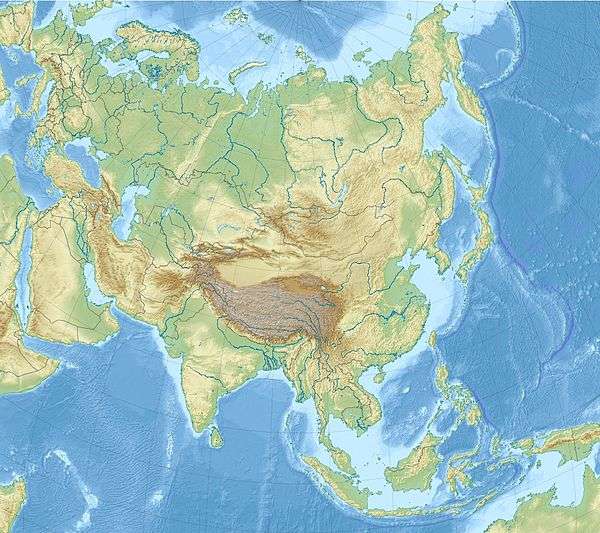Issyk kurgan
The Issyk kurgan, in south-eastern Kazakhstan, less than 20 km east from the Talgar alluvial fan, near Issyk, is a burial mound discovered in 1969. It has a height of six meters and a circumference of sixty meters. It is dated to the 4th or 3rd century BC.[1][2] A notable item is a silver cup bearing an inscription. The finds are on display in Nur-Sultan. It is associated with the Saka peoples.[3]
One of the kurgans at Issyk | |
 Shown within Asia  Issyk kurgan (Kazakhstan) | |
| Coordinates | 43.330008°N 77.618652°E |
|---|---|
| Type | Kurgan |
"Golden man"
Situated in eastern Scythia just north of Sogdiana, the kurgan contained a skeleton, warrior's equipment, and assorted funerary goods, including 4,000 gold ornaments. Although the sex of the skeleton is uncertain, it may have been an 18-year-old Saka (Scythian) prince or princess.
The richness of the burial items led the skeleton to be dubbed the "golden man" or "golden princess", with the "golden man" subsequently being adopted as one of the symbols of modern Kazakhstan. A likeness crowns the Independence Monument on the central square of Almaty. Its depiction may also be found on the Presidential Standard of Nursultan Nazarbayev.
The Issyk inscription
A text was found on a silver bowl in Issyk kurgan, dated approximately VI BC. The context of the burial gifts indicates that it may belong to Saka tribes.
The Issyk inscription is not yet certainly deciphered, and is probably in a Scythian dialect, constituting one of very few autochthonous epigraphic traces of that language. Harmatta (1999), using the Kharoṣṭhī script, identifies the language as Khotanese Saka dialect spoken by the Kushans.[4]
Golden treasures in the kurgan
- "Golden Man"
- Elk. Burial mound Issyk (5th–4th centuries BC)
- Horse. Burial mound Issyk (5th–4th centuries BC)
- Head of tiger, burial mound Issyk (5th–4th centuries BC)
- Flying elk with griffin burial mound Issyk (5th–4th centuries BC)
Notes
- Chang, Claudia (2017). Rethinking Prehistoric Central Asia: Shepherds, Farmers, and Nomads. Routledge. p. 72. ISBN 9781351701587.
- Hall 1997
- Kuzmina 2007, p. 103 "The dress of Iranian-speaking Saka and Scythians is easily reconstructed on the basis of... numerous archaeological discoveries from the Ukraine to the Altai, particularly at Issyk in Kazakhstan... at Pazyryk... and Ak-Alakha"
- Ahmet Kanlidere, in: M. Ocak, H. C. Güzel, C. Oğuz, O. Karatay: The Turks: Early ages. Yeni Türkiye 2002, p.417.
References
- Hall, Mark E. Towards an absolute chronology for the Iron Age of Inner Asia. Antiquity 71 (1997): 863-874.
- Harmatta, Janos. History of Civilization of Central Asia. Volume 2, Motilal Banarsidass (1999), ISBN 81-208-1408-8, p. 421
- Kuzmina, Elena Kuzmina (2007). The Origin of the Indo-Iranians. BRILL. ISBN 900416054X.CS1 maint: ref=harv (link)